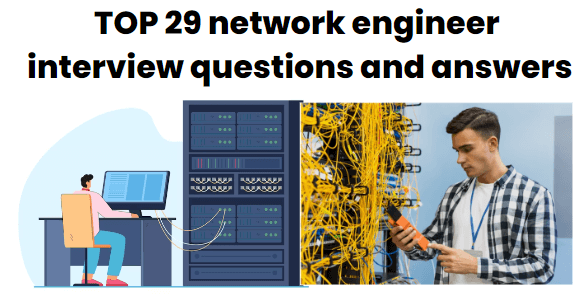in this blog we will provide you Top 29 network engineer interview questions and answers. It can help you in getting your desired career as a network engineer.
These network engineer interview questions and answers cover a wide range of topics and might help you prepare for a network engineer interview. Remember to further research each topic and tailor your answers to your own experience and expertise. Good luck!

TOP 29 network engineer interview questions and answers
Q1. What is the OSI model and how does it relate to networking ?
Answer: The OSI (Open Systems Interconnection) model is a conceptual framework that defines how different networking protocols interact. It consists of seven layers, each responsible for specific functions such as data encapsulation, routing and application support.
Q2. What is the difference between TCP and UDP ?
Answer: TCP (Transmission Control Protocol) provides reliable, connection-oriented communication with error-checking and retransmission mechanisms. UDP (User Datagram Protocol) is connectionless and offers faster but less reliable communication.
Q3. Explain the purpose of DHCP in a network.
Answer: DHCP (Dynamic Host Configuration Protocol) is used to assign IP addresses dynamically to devices on a network. It simplifies IP management by automatically allocating and renewing IP addresses as devices connect and disconnect.
Q4.What is a subnet mask ?
Answer: A subnet mask is a 32-bit value used in conjunction with an IP address to identify the network and host portions of the address. It helps determine which part of an IP address belongs to the network and which part identifies the specific device.
Q5. How does NAT (Network Address Translation) work ?
Answer: NAT translates IP addresses from one network to another, enabling multiple devices to share a single public IP address. It modifies the source and destination IP addresses in IP packets as they pass through a NAT device.
Q6. What is VLAN (Virtual Local Area Network) ?
Answer: VLAN is a logical segmentation of a physical network into separate broadcast domains. It allows the creation of multiple virtual networks within a single physical network infrastructure, enhancing security and network management.
Q7. What is the purpose of a firewall in network security ?
Answer: A firewall acts as a barrier between internal and external networks, controlling incoming and outgoing network traffic based on predefined security rules. It helps prevent unauthorized access and protects against network threats.
Q8. Explain the difference between a router and a switch.
Answer: A router is a networking device that connects multiple networks and forwards data packets between them. It operates at the network layer (Layer 3) of the OSI model. A switch on the other hand, connects devices within a network and operates at the data link layer (Layer 2).
Q9. What is a DNS server and what role does it play in networking ?
Answer: A DNS (Domain Name System) server translates domain names for example www.example.com into their corresponding IP addresses. it enables users to access websites using human-readable domain names instead of numerical IP addresses.
Q10.What is the purpose of a proxy server ?
Answer: A proxy server acts as an intermediary between clients and servers. It forwards client requests to servers and returns the responses to clients, helping improve performance, security and caching.
Q11. Describe the process of subnetting.
Answer: Subnetting involves dividing a network into smaller subnetworks, allowing more efficient IP address allocation. It involves borrowing bits from the host portion of the IP address to create a larger network prefix, enabling multiple subnets within the network.
Q12. How does STP (Spanning Tree Protocol) work ?
Answer: STP is a protocol used to prevent loops in Ethernet networks. It determines the most efficient path through a network by blocking redundant links and allowing for network redundancy in case of link failures.
Q13. What is the purpose of VPN (Virtual Private Network) ?
Answer: VPN provides secure, encrypted connections over an untrusted network (e.g., the internet). It allows remote users to access a private network as if they were physically present, ensuring data confidentiality and integrity.
Q14. What is the difference between a hub and a switch ?
Answer: A hub is a simple networking device that broadcasts data to all connected devices, whereas a switch intelligently forwards data to the intended recipient only. Switches provide better performance and security compared to hubs.
network engineer interview questions and answers
Q15. How does QoS (Quality of Service) improve network performance ?
Answer: QoS prioritizes network traffic to ensure that critical applications receive sufficient bandwidth and lower-priority traffic does not overwhelm the network. It helps maintain optimal performance for real-time applications such as voice and video.
Q16. What are the benefits of using IPv6 over IPv4 ?
Answer: IPv6 offers a significantly larger address space, improved security features, and better support for emerging technologies. It also eliminates the need for NAT in many cases and simplifies network configuration.
Q17. Explain the concept of routing protocols.
Answer: Routing protocols determine the best path for network traffic based on various factors such as network congestion, link availability and cost. They allow routers to exchange routing information and maintain up-to-date network maps.
Q18. How does ARP (Address Resolution Protocol) work ?
Answer: ARP is used to resolve IP addresses to their corresponding MAC addresses on a local network. When a device needs to send data to another device it sends an ARP request to obtain the MAC address of the destination device.
Q19. What is the purpose of an ACL (Access Control List) ?
Answer: An ACL is a set of rules that defines what network traffic is allowed or denied. It filters network traffic based on criteria such as source/destination IP addresses, protocols and port numbers, enhancing network security and control.
Q20. How does BGP (Border Gateway Protocol) contribute to internet routing ?
Answer: BGP is an exterior gateway protocol used for routing between autonomous systems (ASes) on the internet. It allows different networks to exchange routing information and determine the best paths for traffic between them.
Q21. Explain the concept of load balancing.
Answer: Load balancing distributes network traffic across multiple servers or network paths to optimize resource utilization, maximize throughput, and improve reliability. It helps prevent overloading of individual resources.
Q22. What is the purpose of SNMP (Simple Network Management Protocol) ?
Answer: SNMP is a protocol used to manage and monitor network devices. It allows network administrators to collect information, configure devices and receive notifications about network events, facilitating network troubleshooting and management.
Q23 What is the difference between half-duplex and full-duplex communication ?
Answer: In half-duplex communication, data can flow in only one direction at a time. When one party is transmitting the other can only receive. In full-duplex communication, data can flow in both directions simultaneously, enabling simultaneous sending and receiving.
Q24. What is a MAC address and how is it unique ?
Answer: A MAC (Media Access Control) address is a unique identifier assigned to network interfaces at the data link layer. It is a 48-bit value that ensures the uniqueness of each network interface card worldwide.
Q25. Explain the concept of VLAN trunking.
Answer: VLAN trunking allows multiple VLANs to be transmitted over a single physical link between switches. It uses VLAN tagging to identify VLAN membership of incoming traffic, enabling the transport of multiple VLANs across the network.
Q26. What are the different types of network topologies ?
Answer: Common network topologies include bus, star, ring, mesh, and hybrid topologies. Each has its own advantages and disadvantages in terms of cost, scalability and fault tolerance.
Q27. How does an SSL/TLS certificate contribute to network security ?
Answer: SSL/TLS certificates provide secure, encrypted communication over the internet. They verify the identity of websites and encrypt data transmitted between clients and servers, ensuring confidentiality and integrity.
Q28. Explain the concept of port forwarding.
Answer: Port forwarding allows incoming network traffic on a specific port to be forwarded to a different port or destination IP address. It is commonly used to enable remote access to services behind a firewall or NAT device.
Q29. What steps would you take to troubleshoot a network connectivity issue ?
Answer: Troubleshooting network connectivity issues typically involves several steps, including verifying physical connections, checking IP configurations, testing network reachability, examining firewall and routing configurations and using diagnostic tools like ping and traceroute to isolate the problem.
you can also download network engineer interview questions and answers pdf click here
This is all aboutTOP 29 network engineer interview questions and answers . i thinks this will help you to get your dream Job.In The next blog we will discuss about other topic For More Please follow us on twitter.com/einfonett and please keep visiting einfonet.in

